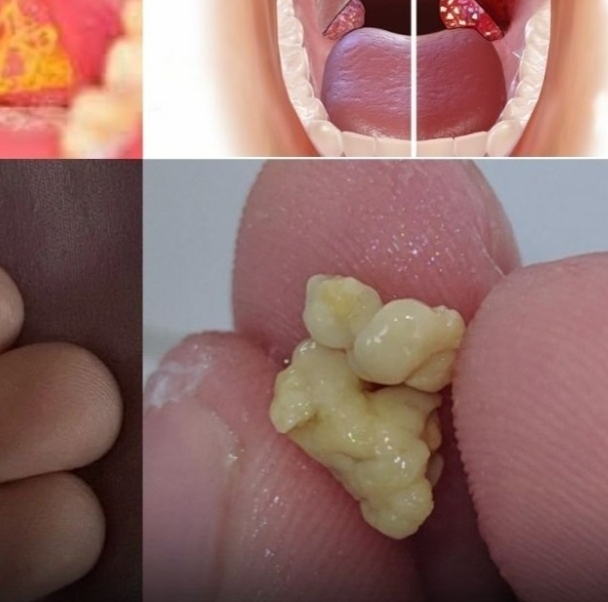🦷 Causes of White or Yellow Balls on the Tonsils – What They Are & How to Treat Them
Have you ever looked in the mirror, opened your mouth wide, and noticed something strange near the back of your throat — small white or yellowish lumps stuck to your tonsils?
You’re not alone. These little bumps are more common than you might think. While they may look alarming, they’re usually harmless. Still, it’s important to understand what causes them and when they might signal something more serious.
In this article, we’ll cover:
What these white or yellow balls on the tonsils are
The most common causes
When to see a doctor
Natural remedies and treatment options
Tips for creating high-interest health content
Let’s explore the facts behind this surprisingly common issue.
🧬 What Are Those White or Yellow Balls on the Tonsils?
The white or yellowish lumps you may notice lodged in your tonsils are commonly known as tonsil stones (or tonsilloliths). These small, calcified formations develop in the crevices of the tonsils and can range in size from tiny specks to pea-sized clusters.
Tonsil stones are typically composed of:
Bacteria
Dead cells
Mucus
Food particles
Calcium deposits
Over time, this material becomes trapped in the folds of the tonsils and hardens, forming the characteristic white or yellowish lumps.
🔍 Common Causes of Tonsil Stones
Tonsil stones form when debris gets lodged in the natural pockets (crypts) of the tonsils. Common causes include:
Chronic Tonsillitis
Recurring inflammation increases the number of crevices in the tonsils, making them more prone to trapping debris.
Poor Oral Hygiene
Irregular brushing and flossing allow bacteria and food particles to build up, especially in the back of the mouth.
Post-Nasal Drip
Mucus from allergies, colds, or sinus infections can drip down the throat, mixing with bacteria and contributing to stone formation.
Dry Mouth
A lack of saliva fosters bacterial growth and allows debris to accumulate more easily.
Large Tonsil Crypts
Some people naturally have deeper tonsil crevices, which can trap more particles.
High Dairy Intake
Dairy products can thicken mucus and increase the likelihood of plaque buildup on the tonsils.
🤒 Symptoms of Tonsil Stones
Not everyone experiences symptoms, but common ones include:
Bad breath (halitosis) — often the most noticeable sign
Sore throat or throat irritation
A sensation of something stuck in your throat
Difficulty swallowing
Ear pain (due to shared nerve pathways)
Visible white or yellow spots on the tonsils
If you notice these symptoms, tonsil stones could be the cause.
💡 Are Tonsil Stones Dangerous?
In most cases, tonsil stones are not dangerous — just uncomfortable or embarrassing. However, larger stones or chronic cases can lead to:
Persistent bad breath
Swollen tonsils
Recurring sore throats
Infections or abscesses
If you have frequent or painful stones, it’s worth consulting an ENT (ear, nose, and throat) specialist.
🧼 How to Get Rid of Tonsil Stones
🧼 How to Get Rid of Tonsil StonesHere are safe and effective ways to remove tonsil stones at home or with professional help:Gargle with Salt WaterHelps loosen stones and reduce inflammation. Gargle multiple times a day, especially after eating.Use a Cotton Swab or ToothbrushGently press around the stone to dislodge it — be cautious not to injure the tonsils.Irrigate with a Water FlosserA low-pressure oral irrigator (like a Waterpik) can flush out debris from tonsil crevices.Stay HydratedDrinking water keeps your mouth moist and helps reduce bacteria.Practice Good Oral HygieneBrush your teeth and tongue, and use an alcohol-free mouthwash to reduce buildup.Visit an ENT SpecialistFor persistent cases, medical professionals can remove stones or recommend treatments like laser resurfacing or tonsillectomy.🩺 When to See a DoctorSee a healthcare provider if you experience:Frequent tonsil stonesSevere pain or difficulty swallowingHigh fever or swollen tonsilsSigns of infection (redness, pus, or ear pain)Persistent bad breath despite good hygieneAn ENT can assess whether more advanced treatment is needed.🛡️ How to Prevent Tonsil StonesPreventive strategies include:Brushing and flossing dailyUsing alcohol-free mouthwashStaying well-hydratedReducing dairy intake, especially before bedAvoiding smokingConsidering a tonsillectomy for chronic casesIn some cases, procedures like coblation or laser cryptolysis can reduce the size of tonsil crypts and prevent stone formation.🧪 Tonsil Stones vs. Other ConditionsIt’s easy to confuse tonsil stones with other conditions. Here’s a comparison:Condition Description Key DifferencesTonsil Stones White/yellow lumps on tonsils Usually painless; may cause bad breathStrep Throat Bacterial infection Sudden sore throat, fever; no visible stonesStrep Carrier No symptoms but positive strep test No pain, but strep bacteria presentOral Thrush Fungal infection (often in mouth) White patches that wipe off; usually on tongue or cheeksTonsillitis Inflammation of the tonsils Red, swollen tonsils; may or may not include pusWhen unsure, always consult a healthcare provider for a proper diagnosis.🧾 Final ThoughtsWhite or yellow balls on the tonsils are usually tonsil stones — harmless buildups of debris, bacteria, and mucus that harden in the tonsil crypts. While they may be uncomfortable or embarrassing, they can often be managed through proper hygiene, hydration, and lifestyle changes. For recurring or painful cases, medical treatments are available.

